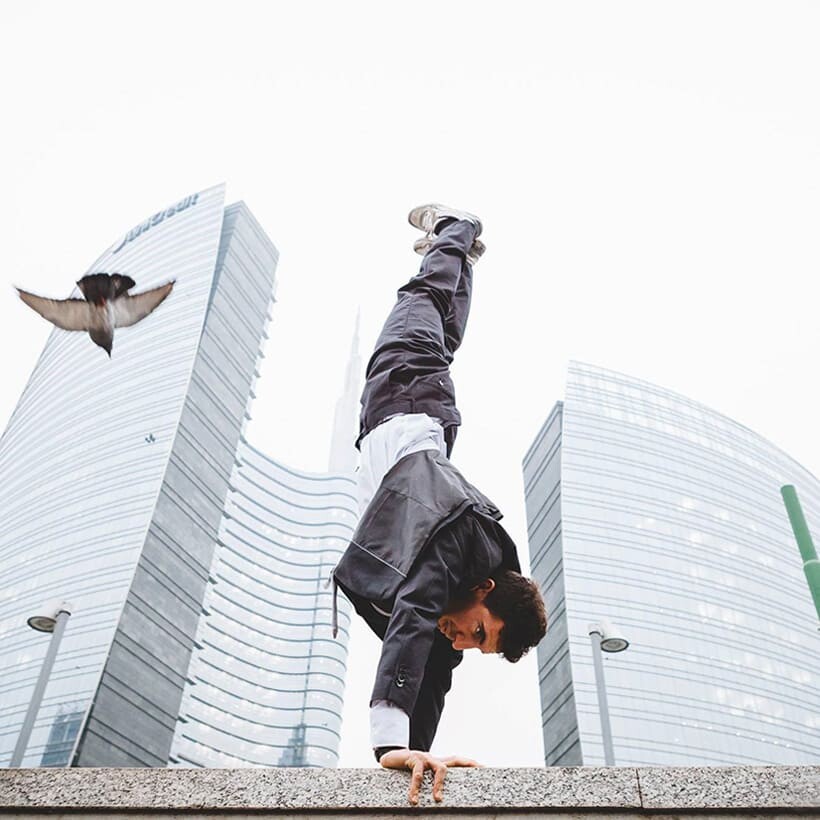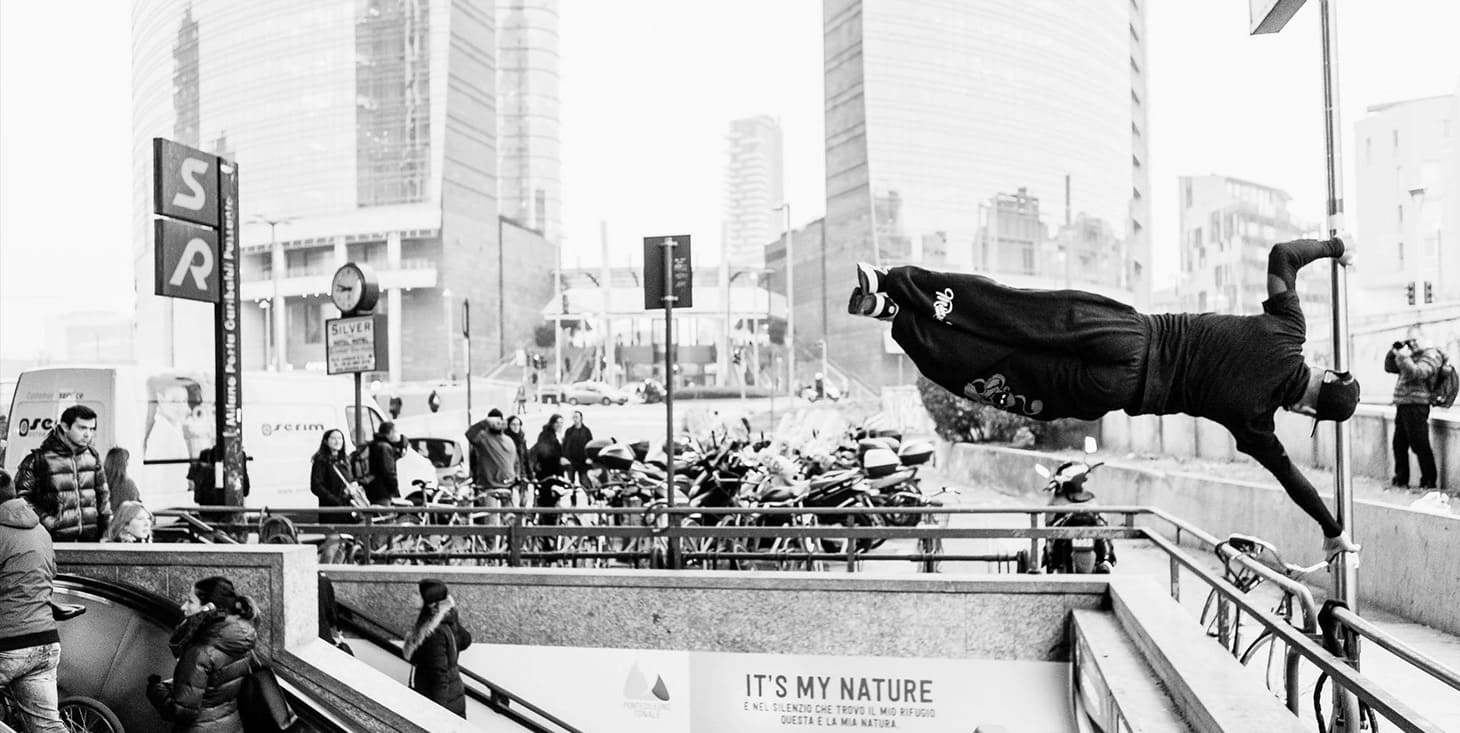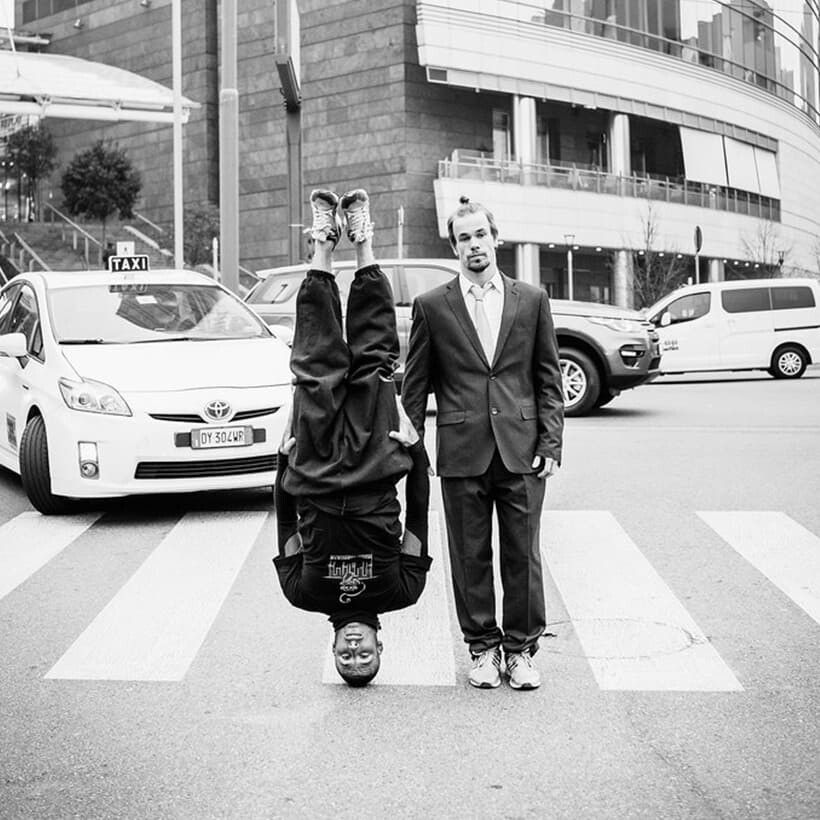You don’t need to climb a skyscraper to be king of the kong
We’ve seen them jump and land on the walls, railings, and steps of the Garibaldi underground station or in Via Pepe, beside the Isola district. And we’ve witnessed the so-called “kong” jump, inherited from the acrobatics of young monkeys. We’re talking about parkour: a discipline born in France in the mid-80s, involving running, climbing, and spinning at high speeds across an urban itinerary studded with military-style obstacles. To find out more about this activity – which has become a web sensation – we interviewed Davide Polli, a legendary traceur (that’s how they call parkour athletes), president of A.S.D. Parkour Milano, and among the founders of Milan Monkeys | Parkour & Freerunning. Davide “traced” the map of parkour spots for us and drew a thick line between parkour and free running, hopping from the topic of safety to the relationship with the city, and from YouTubers looking for likes to his favourite thing in the world: the smile of children when they admire true ninjas in action.
PN: Your website opens with a quote by Nietzsche: “Man is more monkey than any monkey”. Before we “jump” to any conclusion, what do you mean by that?
DP: To never forget our animal side, because we are not only people moving our fingers in front of a computer screen. Society has atrophied our animal mobility, equipping us with a myriad of concoctions that help us but are also “against our nature”.
PN: How did you get into parkour?
DP: I’ve always been an athlete. When I was 6 years old, I was a freestyle snowboarder, and in Milan, I got into gymnastics, breakdance, and skateboarding. People talked about parkour like something distant. When the first few national events started, we were about 40 odd birds, or odd monkeys rather! We did online research and practiced outdoors, making up random training plans. Then we specialized and went to meet the founding fathers in France – all over 50, who still train today! Meeting them gave us a method. So we tapped into their teachings, gymnastics, and martial arts, and we created our own style. We grew, and in 2008 we organized promotional Sunday gatherings for friends and lovers of “motion”.

PN: What do you call a parkour athlete. Parkourer? Monkey?
DP: Traceur, tracer. Because we trace lines. The basic idea is to overcome obstacles separating you from the finish line, while running in the straightest line possible.
PN: What is the difference between parkour and free running?
DP: In my opinion, parkour is developed in the scope of safety, efficiency, and speed. Any somersault or unnecessary acrobatics such as frontflips or backflips is not parkour. Parkour was born in the military context, thus doesn’t include such “variations on the topic”, otherwise it’s free running. Parkour is efficiency, free running is a show. I’m talking as a “purist” traceur. I was one of the first free runners ever, but the purists still survive. The thing is that in the eyes of a child, if you perform a somersault you’re a ninja, and gain respect and appeal.
PN: People normally think that parkour has to do with height, rooftops, and not knowing what comes after each jump.
DP: The problem is that the media doesn’t run in parallel with information. Besides, parkour doesn’t have to do with verticality, and must always be safe. We live in a world where to be popular on social networks, you need to jump off the fourth floor, because society expects you to. We’ve shot TV series and commercials, but we did so after years and years of training, and because we have sponsors, not because someone is filming us with his smartphone.
Before the followers and likes, there is my safety: those who dare don’t do parkour, because our challenges are always controlled. People linked us to those who dive from balconies into pools, or those who surf trains, or even those who sit on train tracks and wait until the last second to move before getting run over. It’s simply ignorance concerning our activity. The harmful consequences are idolizations, videos done by kids… Us, we teach you to leave your comfort zone. If I tell you to simply jump forward you’re okay, but if I take you up high, or if I introduce a new parameter that your mind needs to process and keep under control, it is the spirit of conservation and fear that keeps you alive, making you take a little step back when you need to stay “in one piece” (and I don’t mean this merely as a purist).
PN: Is there a link between parkour and martial arts?
DP: Repetition, which makes you interiorize technique. You don’t need to think about where you are, but about what you’re doing. As you repeat the same movement a thousand times, you reach the point where nothing else affects you as you perform it. Automatic movements that separate you from the context and boost your concentration skills.
PN: A bit like slackline, where people cross a gorge on a rope as if they were 10 cm (4 in.) above ground in their backyard, where they started years earlier...
DP: Exactly, you need to train not just your muscles, but your brain too. Everyone has a primeval sense of vertigo, so it’s only through practice that you reach that state of mental balance allowing you to be in control. Back to martial arts, as well as falling techniques, there are some similarities with the “butterfly twist” kicks in wushu.

PN: Parkour is viewed as “illegal” because it’s done in the street and without “social permission”, just like skateboarding or street art... Besides, we’ve seen that when the institutions offer spaces for legal graffiti, you lose that thrill of the spray can clicking in the dark. What do you think?
DP: If you ride a kick scooter at 25 km/h (15.5 mph) on a sidewalk, you’re part of the urban landscape. If we perform in areas like Bicocca, the safety guards will tell us to leave just because we’re doing gymnastics outdoors.
PN: Is it perhaps a matter of safety and responsibility in case of an accident?
DP: Bingo! I am also a legal representative, and it hurts to say that we no longer organize those promotional days I mentioned earlier, for insurance reasons. We are a company, and we know how to defend ourselves, but there are lots of “loose dogs” out there and a few irresponsible people that cannot count on this.
PN: I see from your website that you’re very well organized; you offer your art even to advertising and cinema, as well as corporate events. Do you have any anecdotes concerning your “appearances”?
DP: In the beginning, we did a bit of everything to raise funds and gain visibility. As we grew, we developed a structure and built relationships with multinationals in the telephone and automotive sectors. We even went to Sardinia, served and revered, for the ad of a German supercar. Even TV is a nice experience. With Brumotti from Striscia la Notizia (a famous Italian comedy show), we filled squares nationwide with 20 or 30 thousand people. And don’t forget the Italian basketball Final Eight.
PN: You make a statement without compromise on your homepage: you’re the biggest and most important team in Milan. Is it because other teams struggle to last?
DP: If passion doesn’t have a structure, it won’t cut the mustard. Passion is great, but a few somersaults aren’t enough to pay a rent.
PN: What urban furniture do you like to use?
DP: Anything. Traceurs adapt to whatever they find, and the more you practice, the more you learn to use more things. Experience opens up a world of uses; you get creative. Sometimes I take beginners to places with three walls and a sidewalk; they look at me puzzled, because they cannot imagine how to spend a whole hour there. Little do they know, I could make up exercises to do there for four hours, not one!
PN: Do you use protections?
DP: No. If you work well you don’t need any. It’s the body that protects itself over time with different calluses and the like.

PN: What’s your coolest trick?
DP: The double kong or double monkey , which mimics a real movement young monkeys make (he shows us a video on his smartphone). Then there is the monkey precision, which you can connect to a series of other steps. The cool thing is seeing how much you change and become more relaxed, more self-aware, and stronger.
PN: How many signs has parkour left on your body?
DP: I broke a collarbone while performing a very high gap jump. When you fall, you need to turn vertical motion to longitudinal in order to dissipate energy, but I fell on wet grass from 3 or 4 metres (10-13 ft.) above. It was my fault because I hadn’t checked before.
PN: Do people find you only when you organize an event?
DP: Usually yes, but people do meet you when you train, and that’s when we go a little Hollywood for the joy of little kids.
PN: Where do you practice in Milan?
DP: There is a myriad of places where you can train, but now that we have a gym we have less time and only go around on the weekends. Spots include Bicocca and Romolo, which is historical and fun, but only if you’re good, because it is high up and has lots of sharp corners and marble. Some other pretty locations are Garibaldi, Via Pepe, and the Navigli and Darsena areas.
PN: Where in Garibaldi?
DP: Between the underground exit and Via Pepe. Piazza Gae Aulenti is pretty but flat. I could use it for a show, but not to practice.
PN: What could you stage at Portanuova?
DP: For a show at the BAM, you need structures. I can call up athletes “with firecrackers in their knees”, but after running back and forth a few times, the curtain closes and that’s that. It all depends on the goal. People want ninjas. If you see parkour athletes in action you think “I could do that too”, simply because it’s true: anyone could do what we do because they are natural movements, written in our genes. It’s inside each of us. But not the acrobatics. Total neophytes on their first lesson already interpret what I show them and make it their own, letting the monkey inside them free.
Anyways, my best performance at the BAM is always when I take my little girls there for a stroll!
https://www.milanmonkeys.com/
Photo credits: Filippo De Dionigi